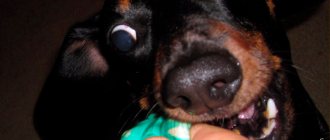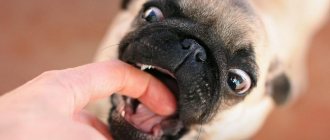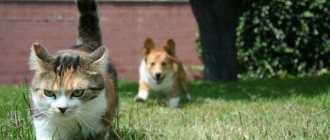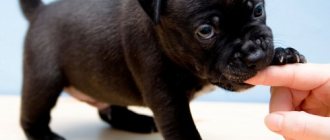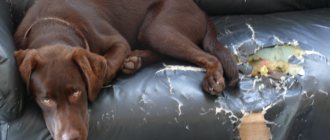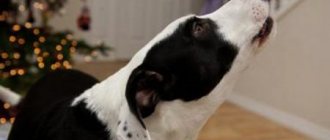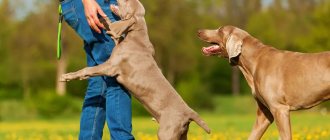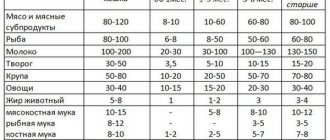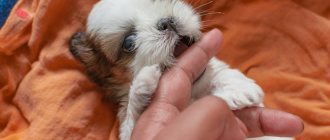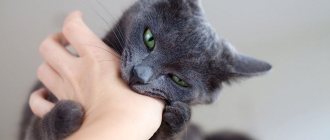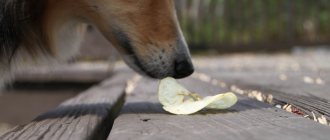Why does a puppy bite its owner?
A dog is a devoted friend to man, but also a social animal, which is characterized by the instincts of its ancestors. They are genetically programmed to use their teeth in the struggle for leadership and survival.
If you raise the animal correctly, the dog will not bite people. However, there are certain reasons that contribute to the manifestation of aggression and uncontrolled behavior of a pet:
- Owners beat dogs in an attempt to gain obedience (such animals pose a threat to others);
- The dog’s desire to take possession of food, position;
- Serious illness of the pet;
- Nervous disorders;
- Jealousy;
- Fear is a product of cowardice and self-doubt.
The reasons for an animal’s bad behavior can have both a physiological and psychological basis.
On a note! Certain breeds of dogs are more prone to aggressive behavior than others. In this case, you cannot do without professional training and education.
In each case, the pet uses its teeth to protect itself from the problem. Only a professional will be able to understand the pet’s condition and take the right steps towards correcting the puppy’s antisocial behavior.
Breed predisposition
Some breeds have pronounced instincts and at the same time a high predisposition to bites. These include hunting, fighting, hounds and other large working breeds. Such dogs need special education, a certain level of activity and correction of aggressive behavior from an early age.
Important! If a dog does not obey, it can cause damage to both its owners and strangers. In this case, it makes sense to contact a professional dog handler.
Bites of decorative breeds and small dogs should also not become habitual behavior and should be encouraged by the owner. Particularly biting breeds include the following:
- dachshund;
- chihuahua;
- Toy Terrier;
- Pomeranian Spitz;
- pit bull;
- bull terrier;
- Rottweiler;
- chow-chow;
- Cocker Spaniel.
How to stop a puppy from biting
A puppy under 4 months of age, due to the presence of milk teeth, cannot control the force of its bite, and therefore during play may painfully bite the owner’s arms or legs. It is important that this innocent habit does not enter adult life.
Puppies cannot calculate their bite force until their baby teeth are replaced by molars.
What to do:
- At the first stage of training, you shouldn’t panic and make a tragedy happen because of a bite, much less scold or scold your pet;
- If the puppy bit you intentionally, then you should use the “fu” command, creating a light slap with your palm in the croup area (the animal cannot be hit on other parts of the body);
- If an accidental bite occurs, for example, during play, you need to stop the activity, wait 10 seconds until the animal calms down, and then continue playing;
If your puppy starts biting during play, you need to pause.
- If biting has become a habit, you need to work thoroughly with your pet in order to avoid serious consequences in the future.
Attention! When raising an animal, it is important to take into account the fact that the pet must be at the level of the hierarchy after all family members; this is the only way to rationally manage it.
Trainers have developed a lot of ways to wean a dog from biting, the main thing is to use commands correctly and get the puppy to strictly follow them. It is important to praise your pet and reward it with its favorite treat.
Moderate use of rewards will motivate your puppy to change behavior.
Video - Weaning a puppy from biting
Why training doesn't work
With regular training, after 2-3 months it is quite possible to wean your dog from biting. The most important thing when raising a pet is not to shout, and especially not to hit. This can lead to even more aggression or fear, which will subsequently break trust and make training more difficult.
The reasons why classes do not bring any results lie in the following:
- Perhaps the puppy does not respect the owner at all and treats him as prey. Seeing a person waving his limbs or running away, her hunting instinct is triggered and she attacks.
- Dogs live in packs, and there is a certain hierarchy among individuals. The pet perceives the owner's family as its pack, and large dominant males may try to take a dominant position. In this case, they will bite, jump on a person and ignore his commands.
- The pet may simply not understand what actions the owner expects from him. This occurs due to improper training, when there is no positive reinforcement for good behavior and punishment for bad behavior.
- There is fear of one person or people in general if the dog has been abused in the past by people or a specific owner.
- The owner is afraid of the dog; the dog, in turn, does not recognize the status of the owner and does not listen to his commands.
- All puppies at the age of 3-4 months have a desire to bite something quite often, in addition, at the same time, the first teeth are cut. It is important that this period does not drag on.
- Sometimes bites are accidental, when the dog is overexcited and, in a fit of emotional upsurge, can give vent to his teeth. This should not be ignored; the dog must understand what behavior is unacceptable even in games.
Note: a dog of any size and temperament must unconditionally listen to its owner and obey commands.
Raising a puppy while playing
It is necessary to wean a dog from biting its owner, animals and strangers at an early age, before teeth change. Since puppies do not yet know how to determine the boundaries between playful behavior and aggression, they may attempt to bite their owner without malicious intent. It is important to let your pet know that exposing its fangs is unacceptable. It is recommended to stop a puppy that is playing too much in the following ways:
- If you notice that the puppy wants to bite, hide your hands behind your back, and when he closes his mouth and does not perform the desired action, praise your pet and give him something tasty;
- During play, you need to make sure that the puppy bites not the hands or feet of the owner, but the toy;
It is important not to give your puppy access to parts of your body, redirecting his activity to other objects
These play forms are suitable for puppies up to 4 months. Afterwards you need to move on to full training and physical punishment. It is important to remember that you cannot show unreasonable aggression towards your pet, destroying the animal’s psyche. Punishments should be understandable to the dog and serve as a lesson to him, and not be a way to discharge his owner.
Outside of play, continue to teach your pet self-control. While at rest, place your fist on your pet’s muzzle; if he bites him, say “no” or “fu-fu”; if not, then click your fingers and reward the dog with a treat. You need to repeat such actions often, several times a day, until the instincts are fixed.
How to avoid failure?
The dog must learn proper habits at an early age. The following measures will make your pet obedient and well-mannered:
- The animal should be taught that grabbing clothes or limbs even during play is unacceptable (to do this, you need to stop playing and leave every time you try).
- The pet should have its own toys that it will bite, tear and spoil.
- The dog should not be allowed to sleep or lie on the bed; the dog must have its own equipped place to sleep and rest.
- You need to feed the dog after the household members have eaten. It is advisable to give your pet a command and, after successfully completing it, reward it with food.
In addition to the recommendations listed, it is important to monitor the condition of your pet - frequency of walking, level of activity, nutrition and health.
How to stop an adult dog from biting
Advice from experienced dog breeders:
- If a violent mood appears, take the pet by the withers and pat it, while using the commands “fu-fu”, stop or not;
Touching the withers will not be perceived painfully by the puppy, but will indicate the boundaries of its permissibility.
- After this, you can continue training - fixing obedience commands, for example, place or sit;
- After each skillful action, praise your pet and give him something tasty;
- You can press the dog to the ground to calm its ardor. It is not recommended to perform such actions with large breed dogs;
- If the dog is small, then you can hold it by the muzzle, immobilizing the jaws (while controlling the pet’s breathing);
Holding large dogs by the jaw is not recommended.
- When playing with your dog, you can turn him over on his back and stroke his belly. It is best if she herself gives the opportunity to rub her on the “soft areas”, recognizing the status of the owner.
Such exercises should be performed alternately, the main thing is that the pet does not feel aggression on your part, but only affection, attention and care. It is equally important to earn and maintain the dog’s respect, then it will freely obey you, respect and obey your household members.
How not to unlearn - common mistakes
An ordinary person, as a rule, does not have training skills and does not know the psychology of dogs. Some of the pet’s antics cause bewilderment or even fear; the owner does not understand where the pet’s aggression comes from and how to deal with it.
How to avoid mistakes when raising a dog:
- If the dog is overexcited and does not obey, you cannot respond to it with any emotions. Actions must be technical and calm, otherwise the animal will never learn discipline.
- Hitting or yelling at the dog is strictly prohibited. From screaming and causing pain, the animal will either get scared or respond with aggression. Physical abuse can lead to mental problems in the dog and damage the dog's trust in people.
- Do not let your pet chew, bite or play with the owner's things. As soon as the dog begins to tinker with such an object or makes attempts, its actions must be stopped immediately.
- Punishment of a dog does not apply to basic needs (walking, food, sleep), since its health depends on them. Even if the dog is completely out of control, it should be punished in other ways.
Certain behavior patterns are determined by temperament, the pet's past history, or genetics. You should pay attention to the individual habits and character traits of your pet. When correcting the behavior of easily excitable dogs, you should be restrained in showing strong emotions, affection, and limit games. Include strictness when the pet stops obeying or showing force to show the dog its place.
Sometimes, unable to cope with raising particularly aggressive, uncontrollable dogs, people either throw them out into the street or kill them. To prevent a sad outcome, it is better to consult a dog handler or take special courses under the supervision of experienced specialists. This is especially true for owners of large breeds.
Learn to bite correctly
In fact, from birth a dog does not know how to bite correctly, and only with the help of the skillful actions of a specialist can the animal’s instincts be corrected. If necessary, it is necessary to stimulate the actions of “biting” as early as possible.
However, you should not train your dog to grab the owner’s clothes or special suit. It is also forbidden to look your pet in the eyes, which will involuntarily allow him to retreat. By averting your eyes, you provoke aggression in the animal, like prey trying to escape.
A huge role in building relationships with a puppy is given to the emotional reactions of the owner.
Attention! As soon as the dog grabs the rag (roller, cuff), you need to tease the pet for a few seconds, and then release the bait and reward the pet with delicious food.
Over time, increase the size of the roller, holding it both vertically and horizontally, honing the actions of the animal. It is important to practice grip stability, and threats should be sharp and loud, without force on the pet.
When raising a pet, the owner must show confidence, which will soon be transferred to the puppy.
Correct actions by the trainer will give the dog confidence and make its behavior controlled. Such a dog will not show unbridled aggression towards others, unlike a cowardly animal.
What not to do during behavior adjustment
Often, owners themselves make mistakes or use prohibited training methods on the puppy. It is important to remember that the goal is how to wean a puppy from biting, and not to turn it into a downtrodden or aggressive animal.
Errors and invalid methods:
- You cannot shout at the puppy, scold unnecessarily, much less beat him.
- It is important to avoid playing with hands, feet and household items.
- It is forbidden to punish a child with “walking” and “food”. These are the basic needs on which a puppy’s life depends.
- You can't show fear or fear.
- You cannot hit the puppy with your hands, equipment, or toys.
- It is strictly forbidden to train a young dog yourself.
Tactics for dealing with an adult pet
If a puppy can be weaned from biting in a few months, then with an adult dog the situation is more serious.
On a note! If the dog has not bitten before, and suddenly starts doing this, reconsider your approach to the pet, perhaps you have become ruder, a new family member has appeared, towards whom the dog does not have friendly feelings. Maybe someone offended the dog, because aggression is a response to physical punishment.
The reason for a puppy’s aggression can also be inhumane treatment of him, calling for protest
How to fix the situation:
- When communicating with your pet, do not use games that can exacerbate the desire to “bite”;
- Physical punishment should not be used; this method of education will increase the degree of aggressiveness of the animal;
- If a pet is loyal to its owner, it will not cause him pain, because the animal is capable of understanding and experiencing human emotions;
If a pet trusts its owner, it will not want to hurt him
- A dog can bite an owner if it does not recognize him as a leader, much less dominates him. Often such situations happen to a child when the dog perceives him as a brother. In this case, serious training will be required, during which the concepts of who is who are identified.
The dog is forced to recognize the superiority of the owner, however, one cannot go too far - not giving food, toys or depriving him of a walk. All actions must be tolerant and careful.
Let's take an example from the street
During a walk, the owner should monitor the behavior of the pet, namely, take a closer look at how it behaves when communicating with relatives or other people. If an animal shows aggression, attacks, or hurts other dogs, then it is necessary to take a thorough approach to its upbringing.
How to reduce and control your pet’s aggressive behavior:
- socialize your dog from an early age;
- cultivate self-control, teach the dog to obey its owner;
- walk the animal on a leash;
- do not keep your pet in a confined space for a long time;
- use special shock collars.
The dog is taught to wear a collar and leash from a young age. As a rule, puppies wear soft fabric harnesses, and then gradually switch to classic types of collars.
Note: if the dog behaved calmly around other people/animals, you should reward it with a treat.
You should not pull the leash or suppress the puppy at the slightest grin or growl, but it is necessary to punish for aggressive behavior.
Pet training methods
There are some myths about raising a pet, what you can do and what you can’t do when trying to wean a dog from biting its owner or damaging the household’s things.
Table 1. Parenting methods and their consequences
| Wrong methods | Correct Methods |
| Let the situation take its course, they say - he will outgrow it, and with age he will understand that this cannot be done | If the puppy grabs your hand during play, then make a sharp, piercing exclamation “aarp”, which will allow the pet to recoil from the “prey” |
| Hitting the dog, which will lead to hidden anger, which over time can develop into uncontrollable aggression | Switch your attention to a toy that does not make sounds, which means it will be an excellent way to play with your puppy |
| Stop playing with the puppy altogether, reducing the risk of being bitten. The method is considered incorrect, since it is important not to avoid the problem, but to solve it | If the puppy bites, stop playing, leave the area and ignore the animal for 15 minutes, and then return to play. If necessary, repeat the steps |
Thus, the desire to bite will disappear. Improvement in your pet's behavior will be noticeable from the first lessons. The main thing is to use only humane ways to correct a disobedient puppy.
The child should be familiar with basic commands and be able to use them when communicating with the puppy
Teach children to use the command “shut your mouth”, “fu”, “no” so that they can take the right actions in time. Reward your pet every time the command is performed correctly.
Puppy from 2 to 3 months. Nippers and tactile contact
2 months - This is the usual age when a puppy moves to a new family. If your puppy is younger, it will be more difficult for you, but the principles are the same.
If you are older, I still recommend reading it, because... many rules are tied not only to age, but also to the very fact of a puppy appearing in your home and in your life. Typically, recommendations for raising a puppy include an ideal, complete option - what to do with the puppy. Or a list of instructions - what to do if a puppy, for example, bites - without a general scheme of work. But the truth is that we have a life beyond the puppy. And we simply don’t have time to do everything that is necessary for the ideal. And if the owner does not understand what is important and what is secondary, the result will be sad. You can, for example, focus on learning commands, and at 4 months the puppy will sit, lie, stand and give a paw. But at the same time he will brutally pull on the leash and howl while staying at home. Therefore, for myself - and now for you - I have highlighted what is important, important, important, and what can be done months later. For this period, I would highlight 2 necessary things. Those without which I can’t imagine raising a comfortable dog at home:
1. You need to let the puppy know that you are his family. That you love him and he depends on you. That communicating with you is interesting and useful. 2. It is necessary not to go crazy, not to burn out and not to fall into despair because “he doesn’t understand anything”!
